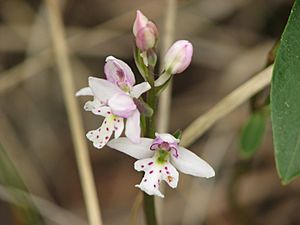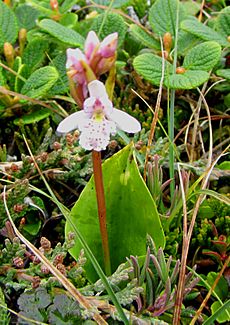Roundleaf orchid facts for kids
Quick facts for kids Roundleaf orchid |
|
|---|---|
 |
|
| Galearis rotundifolia Wagner Natural Area, Alberta |
|
| Conservation status | |
| Scientific classification | |
| Genus: |
Galearis
|
| Species: |
rotundifolia
|
| Synonyms | |
|
|
The Galearis rotundifolia is a type of flowering plant in the orchid family. People often call it the roundleaf orchis or the small round-leaved orchid. This plant grows naturally in North America. You can find it across Canada, in parts of the northern United States, and in Greenland.
Description

The Galearis rotundifolia is a soft, juicy plant that lives for many years. It grows from a thick, underground stem called a rhizome. This plant can grow up to about 33 centimeters tall.
It has one leaf that wraps around the bottom of its stem. This leaf can be different shapes and sizes, growing up to 11 centimeters long. At the top of the stem, there is a cluster of flowers and small, leaf-like parts called bracts. This is called an inflorescence.
The plant can produce up to 18 flowers at one time. Each flower has six parts that look like petals, called tepals. They can be white or light pinkish-purple. Three of these tepals are sepals, which are up to one centimeter long. The other three are shorter, thinner petals. The middle petal has a special shape with a spur and lobes. It is white with pinkish-purple spots and sometimes stripes.
The flower also has two sticky pollen parts called pollinaria. These carry the plant's pollen. After the flower is pollinated, it produces a fruit that is a capsule.
Where it Grows
The Galearis rotundifolia plant is native to northern North America. It is very common and grows widely in the colder northern areas. You can find it in almost all of Canada's provinces, in Greenland, and in Alaska.
It also grows in the northern parts of the contiguous United States. This includes states like Montana, Minnesota, Wisconsin, Michigan, Idaho, New York, Vermont, New Hampshire, and Maine.
Its Home (Habitat)
This orchid lives in very cold places, like arctic and boreal climates. These are areas with long, cold winters. In the northern parts of its range, you can find it in many different types of places. But in the southern areas, it is less common. There, it mostly grows in wet, shady spots.
For example, in the Rocky Mountains of Montana, Idaho, and Wyoming, it likes to grow near streams. It also grows in wet, but well-drained, limestone soils. You can find it in shady spruce forests and woods. This plant is a "glacial relict species," meaning it survived from a time when glaciers covered much of the land.
The most important thing for this orchid's home is a cold ground. In northern regions, it can grow in full sunlight. But in warmer southern areas, it needs shade to protect it. Sometimes, in open, exposed areas like the tundra, it grows as a very small plant.
The ground where it grows is usually moist or wet, but not completely soaked with water. In southern areas, it must grow in wetlands. But farther north, it can grow in wetlands or other damp places. It also needs calcium-rich soils that are not too acidic.
How it Reproduces
The Galearis rotundifolia usually makes new plants by seeds. But sometimes, it can also reproduce without seeds. This is called vegetative reproduction. It might do this using its underground stems (rhizomes or stolons). Or, a new plant (called a ramet) might grow from a group of connected plants and then break off.
Insects help the flowers make seeds. This is called pollination. In one study in Alberta, a type of mason bee called Osmia proxima was the main pollinator. Other insects that helped included several types of hoverflies, like Eriozona laxus and Eristalis hirta.
Scientists saw these insects pushing their mouthparts into the flower's spur. As they did this, the sticky pollen would get stuck on their heads. The orchid's seeds are very tiny and light. They are then carried away by the wind to new places.
Like other orchids, this plant has a special partnership with fungi in its roots. This is called a mycorrhizal association. The fungi help the plant get nutrients from the soil.
Conservation
Overall, the Galearis rotundifolia is a common and safe species. This is especially true in Canada. However, it becomes rare at the southern edges of where it grows.
Some things that threaten this plant include people collecting too many orchids. Also, some people illegally take the plant from the wild to use as an herbal remedy. It's important to protect these beautiful plants so they can continue to grow in nature.


